Characterization of intracellular reverse transcription complexes of human immunodeficiency virus type 1
- PMID: 11264352
- PMCID: PMC114854
- DOI: 10.1128/JVI.75.8.3626-3635.2001
Characterization of intracellular reverse transcription complexes of human immunodeficiency virus type 1
Abstract
To examine the early events of the life cycle of human immunodeficiency virus type 1 (HIV-1), we analyzed the intracellular complexes mediating reverse transcription isolated from acutely infected cells. Partial purification of the reverse transcription complexes (RTCs) by equilibrium density fractionation and velocity sedimentation indicated that two species of RTCs are formed but only one species is able to synthesize DNA. Most of the capsid, matrix, and reverse transcriptase (RT) proteins dissociate from the complex soon after cell infection, but Vpr remains associated with the RTC. The RTCs isolated 1, 4, and 7 h after infection are competent for reverse transcription in vitro, indicating that a small proportion of RT remains associated with them. HIV RTCs isolated early after infection have a sedimentation velocity of approximately 560S. Later, different species with a sedimentation velocity ranging from 350S to 100S appear. Nuclear-associated RTCs have a sedimentation velocity of 80S. Shortly after initiation of reverse transcription, the viral strong-stop DNA within the RTC is sensitive to nuclease digestion and becomes protected when reverse transcription is almost completed.
Figures







References
-
- Farnet C M, Bushman F D. HIV-1 cDNA integration: requirement of HMG I(Y) protein for function of preintegration complexes in vitro. Cell. 1997;88:483–492. - PubMed
Publication types
MeSH terms
Substances
Grants and funding
LinkOut - more resources
Full Text Sources
Other Literature Sources
Molecular Biology Databases

